6 sales strategy examples your competitors don’t want you to know
The best salespeople do everything in their power to create an unfair advantage.
Chris Orlob, John Barrows, and Mark Roberge know a thing or two about how to create this unfair advantage and dominate sales.
Chris was an early Gong guy (Nov ‘16 start date) where he’s served as the Senior Director of Product Marketing followed by the Head of Sales for Existing Accounts. He’s now the Multi-Product Lead. If you look on the Gong blog, you will likely bump into many articles he’s written.
John has been selling for 20+ years. He’s been in pretty much every sales role over those 2+ decades. His current gig is JB Sales, an organization founded “as a response to the incredibly limited amount of formal academic sales training that exists for the #1 global profession.” On LinkedIn, John’s mission is to help elevate the profession of sales. He talks about #sales, #leadership, #coldcalling, #prospecting, and #salesdevelopment.
Mark is a former (longtime) Hubspot executive where he served as the Chief Revenue Officer for the HubSpot Sales Division and the SVP of Worldwide Sales and Services (not at the same time). Mark is currently a Managing Director at Stage 2 Capital AND a Senior Lecturer at Harvard Business School AND the author of the best-seller, “The Sales Acceleration Formula.”
Chris, John, and Mark sat down (virtually, of course) to talk sales strategy. They specifically covered the 6 powerful sales strategy examples your competitors don’t know.
Before we get into the list of 6, let’s be clear about one thing: You can no longer rely on a unique product. To be successful, you must differentiate between what you say, what you do, and what you write during the sales process.
Okay. Let’s dive into the list.
Sales strategy example #1: separate yourself with a nexus
Wait. What? A Nexus?
Nexus: a connection or series of connections linking two or more things.
“the nexus between industry and political power” (via Oxford Languages)
Nexus: a polarizing insight that changes how your customer thinks and feels about the problem you solve or the opportunity you help them exploit (via Chris Orlob, Gong).
80% of customers you pitch your Nexus to will agree with it wholeheartedly and love you even more for it.
20% of customers you pitch your Nexus to will disagree with it; a portion may hate you for it!
Note: Ensure you have the 80/20 as the agree/disagree
There is a tremendous amount of power in sales polarization.
Back in 2007(ish), Hubspot created a Nexus, and as a result, launched a new category of sales:
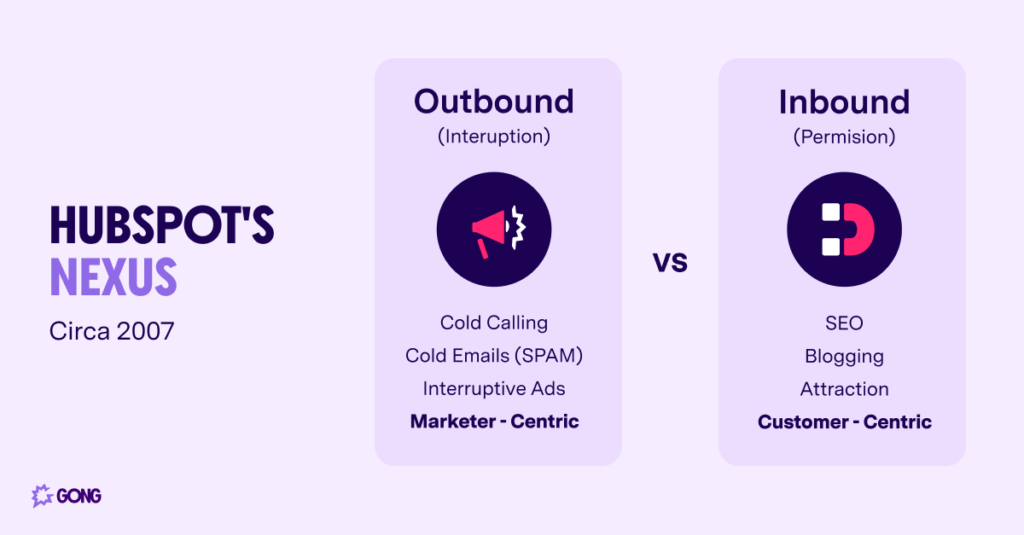
Interruption vs. permission.
Cold calling to SEO.
Cold emailing (SPAM) to blogging.
Interruptive ads to attraction.
Most importantly, marketer-centric to customer-centric.
Inbound marketing was born, thanks to this powerful Nexus.
A compelling Nexus has 4 key attributes:
- Changes how your buyer thinks
- Shakes their confidence
- Is polarizing (of course)
- Is a clear binary statement
Convince them the status quo is not okay.
Sales strategy example #2: sell the micro-problem
“Sell the problem before you sell the solution” is a common phrase in sales.
But we typically do this at the macro level: We sell the business problem our entire solution solves, and then we sell the solution to that business problem.
When it comes to differentiation, we often sell how our solution is unique without selling the problem our solution is intended to address.
Instead: First, sell the problem your uniqueness solves. THEN, introduce your differentiator.
Start by getting your buyer to jump into the “problem box.” There are often multiple ways to solve a problem, but your solution typically covers only a few. You need to understand where your buyer lives before introducing what makes your solution THE problem solver.
Example: If you sell software (especially B2B), you want to steer your buyer into the “BTB software can solve” problem box. THEN, you want to introduce why your BTB software is the best solution for their problem.
Your buyer’s context will dictate how you differentiate because, ultimately, your differentiation is worthless if your buyer doesn’t value it!
Sales strategy example #3: decrease your time-to-value
Get to the point as fast as possible.
If we agree that time – something that is finite and you can’t get back — is the most valuable asset any of us have.
Respect this valuable asset, especially when speaking with the C-Suite.
The sweet spot number of questions asked during discovery calls is between 11 and 14 …
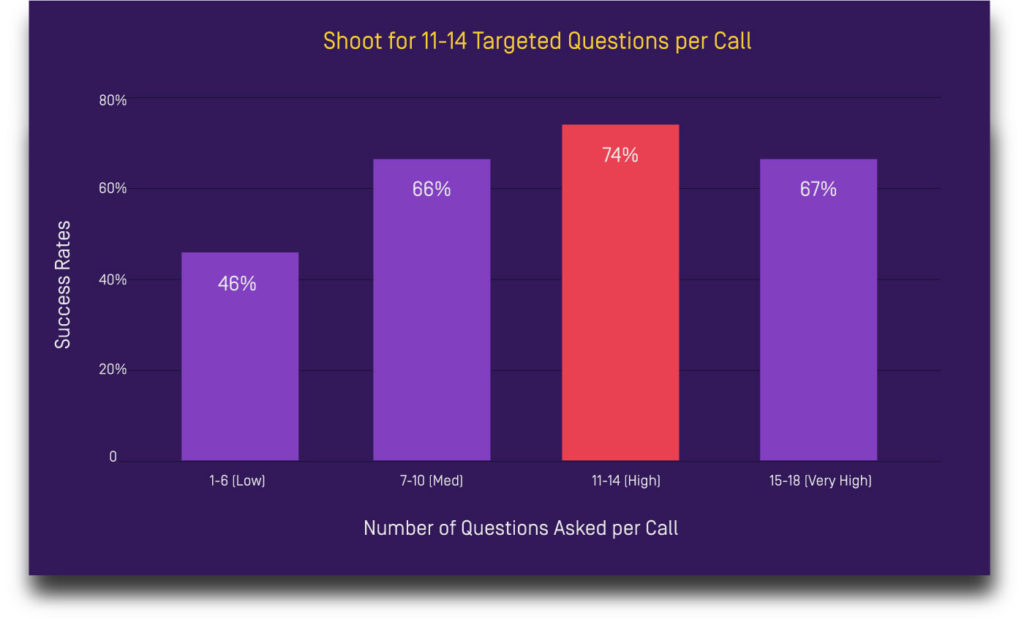
When selling to a C-suite executive, that number is much lower. Your win rates decline after just a few questions:
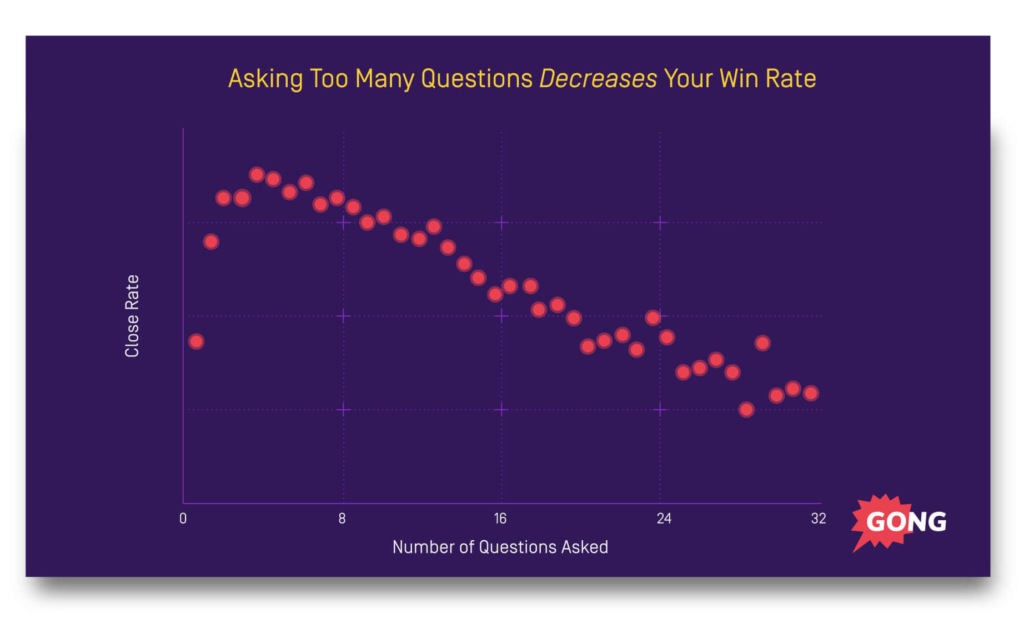
4 is the ideal number of questions when meeting with C-suite executives. Unsuccessful meetings have 8:
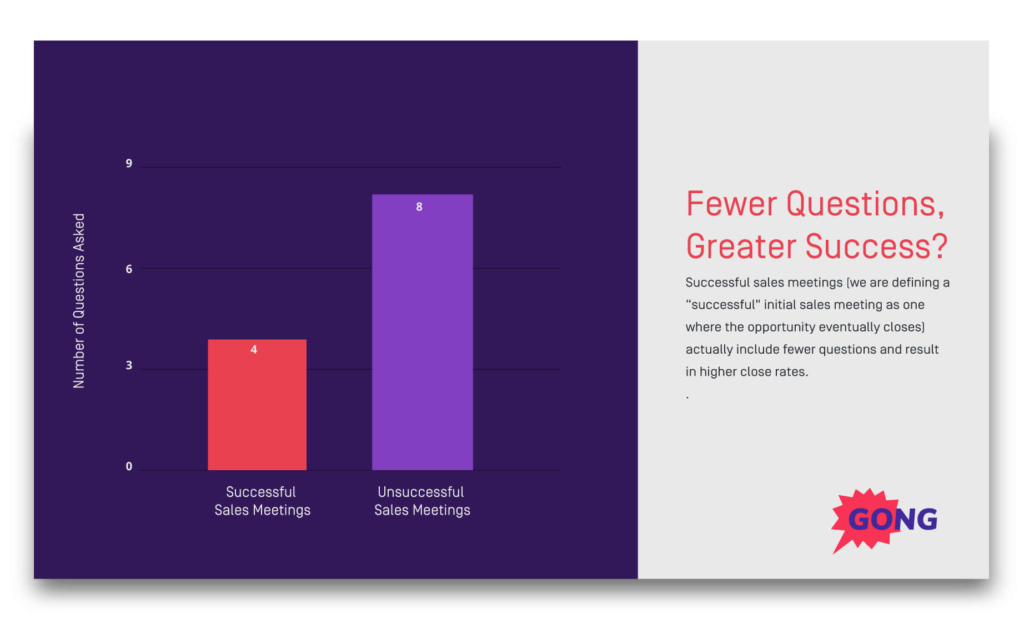
Get to the point … quickly.
Get to value … quickly.
Same for demos: Get to the good stuff, the value, as quickly as possible. A bit of small talk is fine. Building rapport is excellent. But get to it!
For cold calls, get right into the reason for your call. Opening your cold call by stating the reason for calling increases your success rate by 2.1x:
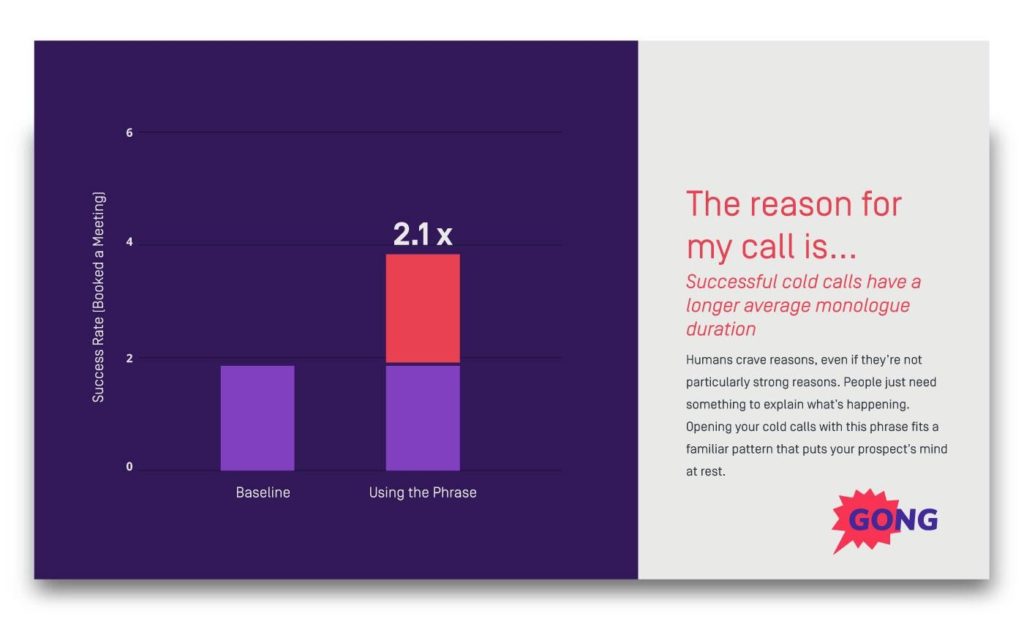
Bonus: Flip your sales demo upside down. See #1 here.
Shorten your time-to-value in every conversation you have with buyers.
Sales strategy example #4: capture the problem better than your competitors do
Tell a familiar but PAINFUL story.
If your story describes their problem better than they can describe it themselves, they will automatically assume you have the best solution.
Alcoholics Anonymous (AA) does this exceptionally well.
Their clientele/audience has one thing in common: Denial. Most have not yet admitted they have an unhealthy relationship with alcohol.
Knowing this, AA does not include testimonials on its website that proclaims, “My life is back on track. My career is solid again. My relationship with my family is great again. AA changed my life.”
Instead, the AA website tells the story that someone with a drinking problem can come to that realization on their own, their self-discovery. Quotes sound more like, “It started with just a couple of drinks on Friday and Saturday nights. That led to a couple of drinks every night. Before I knew it, I couldn’t even wind down every night without 4-5 drinks.
Powerful.
AA has told the story of the problem better than its future customers.
But how do you get salespeople to do this?
Spend more time upfront training new reps more on your buyer’s problems and less on the features and functionality of your product. So much of today’s sales training is about how your product works. Start with the buyer’s problems.
Teach your sales reps what it’s like to be your buyer.
Sales strategy example #5: find a weakness within your competitors’ strength
In the 1980s, McDonald’s was the leader in the burger space. Burger King had the formidable task of figuring out how to take some of that market share.
So they targeted the strength of McDonald’s: Kids — Ronald McDonald. Happy Meals. Playplace. McDonald’s was the place kids loved to go.
So Burger King positioned itself as the place for adults. “Come to Burger King if you want an adult burger.”
Burger King found the weakness in McDonald’s strength.
From a sales perspective, it’s totally fine (maybe even accepted) to compliment your competitors. If they are good at something, it’s okay to call it out. But then move to how you do (other things) better.
Maybe your product or service is a compliment to your competitor.
Sales strategy example #6: train your team to be just 1% better
Note: this sales strategy is for managers and leaders only.
Question: What separates your star reps from the rest?
Answer: A little bit of everything.
Most sales reps have some sort of superpower. But the absolute best of the best reps have a superpower AND are well-rounded in all other sales skills.
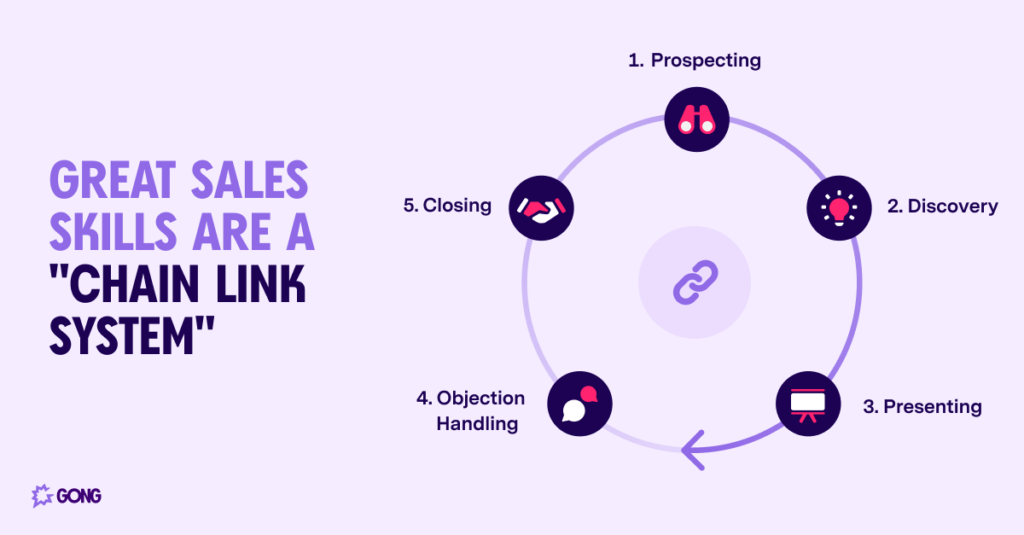
Weak links are no good; they disrupt the entire chain.
Stars handle discovery calls a little bit better than the average rep.
The best reps establish value a little bit better than the average rep.
Top salespeople handle objections a little bit better than the average rep.
All of the above has a compounding effect.
Managers can have a considerable positive (or negative) impact on their team.
Wrong: Spending a lot of time on forecasting.
Wrong: Doing the job of their sales reps.
Right: Hire.
Right: Coach.
Right: Hire and Coach.
Use data and technology to help forecast and understand what each rep needs for coaching.
How do you ensure your reps are using these 6 sales strategies?
One word: Visibility.
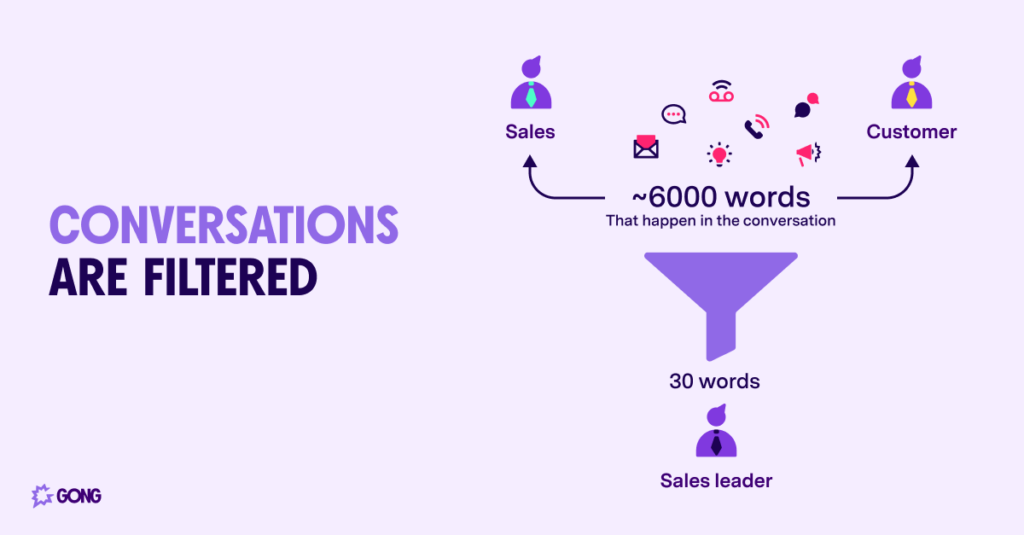
6,000 words in a sales conversation often get filtered (errr … funneled) into about 30 words dumped into your CRM.
Eeks.
You are going into sales conversations blind.
Gong’s Revenue Intelligence platform gives you total visibility — and then some.
Need more marketing and sales strategy inspiration?
Use the 6 sales strategies above and grab The High Growth Sales Strategy Template to get started building an unstoppable revenue engine.